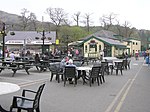Dinorwig Power Station
1984 establishments in WalesBuildings and structures in GwyneddEnergy infrastructure completed in 1984Hydroelectric power stations in WalesLlanddeiniolen ... and 2 more
Pumped-storage hydroelectric power stations in the United KingdomTourism in Gwynedd

The Dinorwig Power Station (; Welsh: [dɪˈnɔrwɪɡ]), known locally as Electric Mountain, or Mynydd Gwefru, is a pumped-storage hydroelectric scheme, near Dinorwig, Llanberis in Snowdonia national park in Gwynedd, north Wales. The scheme can supply a maximum power of 1,728 MW (2,317,000 hp) and has a storage capacity of around 9.1 GWh (33 TJ).
Excerpt from the Wikipedia article Dinorwig Power Station (License: CC BY-SA 3.0, Authors, Images).Dinorwig Power Station
Geographical coordinates (GPS) Address Nearby Places Show on map
Geographical coordinates (GPS)
| Latitude | Longitude |
|---|---|
| N 53.118611111111 ° | E -4.1138888888889 ° |
Address
LL55 4TY , Llanberis
Wales, United Kingdom
Open on Google Maps









